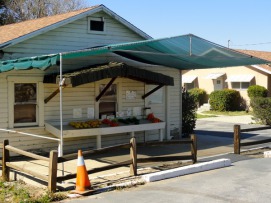http://www.sbsun.com/ci_20031319
Orange you glad you live in the I.E?
John Weeks, Staff Writer
Posted: 02/23/2012 04:47:27 PM PST
The oranges are ripe, the branches are heavy-laden and the groves are heavenly scented, so it's the perfect time of year for one of my favorite Sunday drives.
From San Bernardino I head east to Redlands on the 10 Freeway, exit south on California Street and follow it as it zigzags across Redlands Boulevard. Boom, I'm just minutes from my house, but now I'm in citrus country and it's a hundred years ago.
I stay on California Street as it burrows through dense groves on its way to Barton Road, where I turn east, pass by the old Asistencia mission on my left, then turn south again on Terracina Boulevard, which climbs the hill toward Redlands Community Hospital. The historic Morey Mansion and many other stately homes line the road and many of them feature picturesque orchards.
Better yet, some of the homeowners have set up untended roadside stands where it's possible to buy bags of fresh-picked oranges, lemons and avocados for three or four bucks a pop. You put your money in a cash box.
It's an honor system, and it's an honor, frankly, to take part in such an old-fashioned rite in our new-fangled age.
Once you get up to the hospital, you have your choice of two routes, and I like to take both. I'll continue to the top of Terracina, then start angling south to Highland Avenue and head east through more palatial neighborhoods and groves. Highland Avenue eventually converges into Fifth Avenue, which leads into serious orchard country and the pioneer Farquhar Farms, which has a large produce stand at Fifth and Wabash avenues.
Farquhar was established in 1886 in the early days of the Southern California citrus boom. This is legacy fruit!
After visiting Farquhar, I make my way back to Terracina, then turn left on the little road that descends around the back of the hospital and down into a corner of San Timoteo Canyon. Here are sudden views of whole vistas of remnant citrus groves that stretch south and east into the canyon.
By now I have goosebumps. It's always a thrill to rediscover that we still have these living reminders of the citrus heritage that once defined our Inland Empire.
Of course, then I make my way home, and I read the newspaper, and I learn that Loma Linda has decided it no longer can afford to pay for watering one of its few remnant groves and will abandon it to its fate.
And this reminds me, sadly, of how dwindled indeed our citrus heritage has become.
For most of a century, starting in the 1870s and continuing into the 1960s, the Inland Empire was a bountiful Eden with sprawling orchard lands that stretched from horizon to horizon. There were an estimated 10 million citrus trees in Southern California, and most of them were in San Bernardino and Riverside counties.
This place was a wonderland, and its fame spread. Tourists vacationed here. Celebrities played here. Wealthy families of the East built winter palaces here. The National Orange Show in San Bernardino was a glittery exhibition that attracted huge crowds of visitors each year from around the world.
But then, we decided to change course and seek a new destiny. Southern California land developers needed room to expand and they offered us big money to tear down our groves and replace them with warehouses and apartment complexes and strip malls and parking lots.
Looking back, it's impossible not to wonder if we made the best of our choices.
Citrus is resilient, though, as it turns out. I know it for a fact. I planted an orange tree, a lemon tree and a grapefruit tree almost 30 years ago in my yard, and at first they did poorly. The late great Herb Fischer, founder of Flowerland Nursery in San Bernardino, told me I was overwatering them.
"Don't EVER water citrus," he said, looking me right in the eye. "They get what they need. Leave them alone."
He was right. I pretty much stopped watering my citrus trees. And today they're doing fine.
I'm wondering. That remnant grove in Loma Linda, left alone, may last longer than anyone thinks it will. And that would be a good thing. Loma Linda is where the Inland Empire's very first orange trees were planted, in 1857 by Anson Van Leuven. Let's hope, for history's sake, that Loma Linda still has a few orange trees for many years to come.
We humans are resilient, too. We can rebound. We can review, revise, reroute. We can reconsider old choices of the past, as we strive to make better choices in the future.
To become involved in current, ongoing efforts to preserve and protect remnant groves, contact and join the Inland Orange Conservancy, inlandorange.org, 909-794-4484, P.O. Box 188, Mentone, CA 92359.






